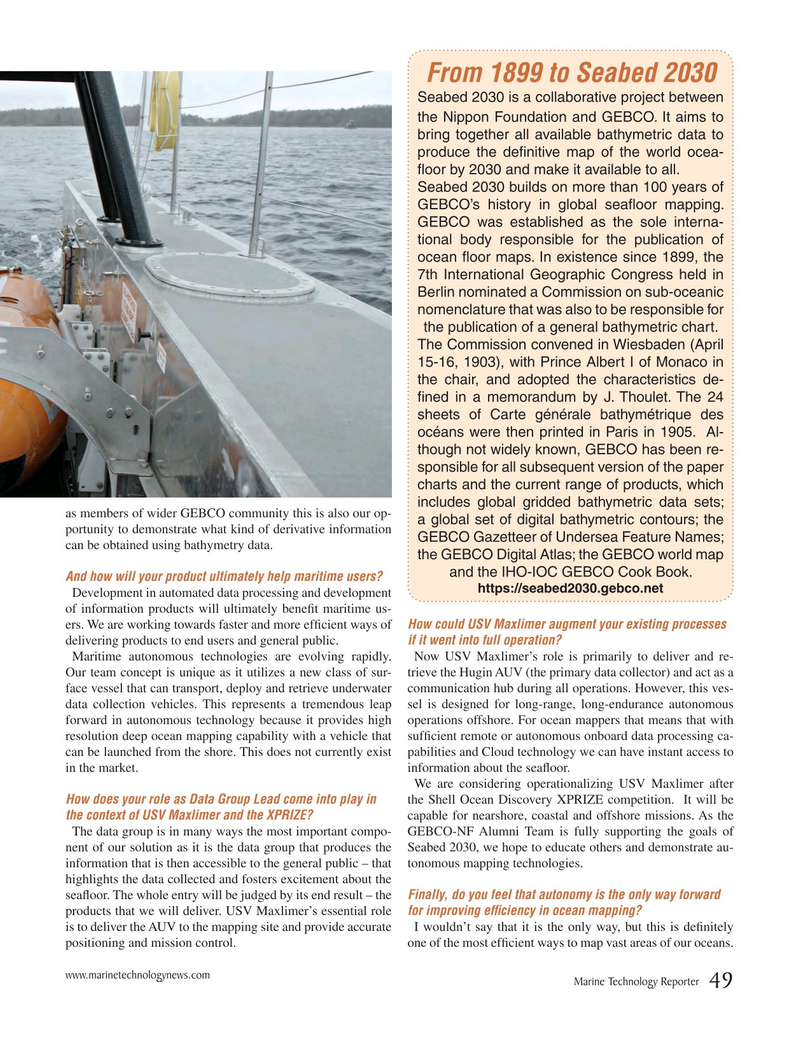
Page 49: of Marine Technology Magazine (September 2018)
Autonomous Vehicle Operations
Read this page in Pdf, Flash or Html5 edition of September 2018 Marine Technology Magazine
From 1899 to Seabed 2030
Seabed 2030 is a collaborative project between the Nippon Foundation and GEBCO. It aims to bring together all available bathymetric data to produce the de? nitive map of the world ocea- ? oor by 2030 and make it available to all.
Seabed 2030 builds on more than 100 years of
GEBCO’s history in global sea? oor mapping.
GEBCO was established as the sole interna- tional body responsible for the publication of ocean ? oor maps. In existence since 1899, the 7th International Geographic Congress held in
Berlin nominated a Commission on sub-oceanic nomenclature that was also to be responsible for the publication of a general bathymetric chart.
The Commission convened in Wiesbaden (April 15-16, 1903), with Prince Albert I of Monaco in the chair, and adopted the characteristics de- ? ned in a memorandum by J. Thoulet. The 24 sheets of Carte générale bathymétrique des océans were then printed in Paris in 1905. Al- though not widely known, GEBCO has been re- sponsible for all subsequent version of the paper charts and the current range of products, which includes global gridded bathymetric data sets; as members of wider GEBCO community this is also our op- a global set of digital bathymetric contours; the portunity to demonstrate what kind of derivative information
GEBCO Gazetteer of Undersea Feature Names; can be obtained using bathymetry data.
the GEBCO Digital Atlas; the GEBCO world map and the IHO-IOC GEBCO Cook Book.
And how will your product ultimately help maritime users?
https://seabed2030.gebco.net
Development in automated data processing and development of information products will ultimately bene? t maritime us- ers. We are working towards faster and more ef? cient ways of How could USV Maxlimer augment your existing processes delivering products to end users and general public. if it went into full operation?
Maritime autonomous technologies are evolving rapidly. Now USV Maxlimer’s role is primarily to deliver and re-
Our team concept is unique as it utilizes a new class of sur- trieve the Hugin AUV (the primary data collector) and act as a face vessel that can transport, deploy and retrieve underwater communication hub during all operations. However, this ves- data collection vehicles. This represents a tremendous leap sel is designed for long-range, long-endurance autonomous forward in autonomous technology because it provides high operations offshore. For ocean mappers that means that with resolution deep ocean mapping capability with a vehicle that suf? cient remote or autonomous onboard data processing ca- can be launched from the shore. This does not currently exist pabilities and Cloud technology we can have instant access to in the market. information about the sea? oor.
We are considering operationalizing USV Maxlimer after
How does your role as Data Group Lead come into play in the Shell Ocean Discovery XPRIZE competition. It will be the context of USV Maxlimer and the XPRIZE? capable for nearshore, coastal and offshore missions. As the
The data group is in many ways the most important compo- GEBCO-NF Alumni Team is fully supporting the goals of nent of our solution as it is the data group that produces the Seabed 2030, we hope to educate others and demonstrate au- information that is then accessible to the general public – that tonomous mapping technologies.
highlights the data collected and fosters excitement about the sea? oor. The whole entry will be judged by its end result – the Finally, do you feel that autonomy is the only way forward products that we will deliver. USV Maxlimer’s essential role for improving ef? ciency in ocean mapping?
is to deliver the AUV to the mapping site and provide accurate I wouldn’t say that it is the only way, but this is de? nitely positioning and mission control. one of the most ef? cient ways to map vast areas of our oceans. www.marinetechnologynews.com
Marine Technology Reporter 49
MTR #7 (34-49).indd 49 MTR #7 (34-49).indd 49 9/6/2018 11:02:36 AM9/6/2018 11:02:36 AM

 48
48

 50
50
